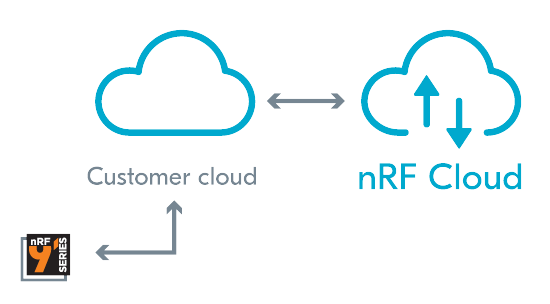Benefits of nRF Cloud
Built from the ground-up for low powerUltra-low power is in Nordic's DNA. Everything we offer to our customers across hardware, software and cloud services, is optimized for ultra-low power. |
|
| |
Agnostic connectivity transportnRF Cloud can be accessed via device-to-cloud or cloud-to-cloud mechanisms, to ensure it fits a variety of use-cases and system architectures. |
| |
Standalone services and pricingIndividual selection of services and features allows for a flexible adoption that meets your needs, and pricing plan options that fit the scale of your business. |
| |
Full lifecycle supportnRF Cloud services can be leveraged across your product's entire lifecycle, from production to field decommissioning, reducing costs associated with proprietary infrastructure |
Protocol agnostic
To fit your needs
There are two main ways of using nRF Cloud Services: Device-to-Cloud and Cloud-to-Cloud.
Device-to-Cloud: The device connects directly to nRF Cloud with a bi-directional CoAP or MQTT.
Cloud-to-Cloud: The device is provisioned to the customer's cloud and that cloud communicates to the nRF Cloud via a REST API. This is ideal for customers that already use their own cloud and provides greater flexibility and control over the device communication workflow.
Device-to-CloudOptimal for power consumption |
Cloud-to-CloudOptimal for flexibility |
 |
 |
| The device registers and provisions with nRF Cloud, and it connects directly to nRF Cloud using a bidirectionally capable protocol (MQTT or CoAP), for customers that don't have a dedicated application cloud or want to keep that separated. This is the ideal approach to leverage nRF Cloud services' deep integration with out devices for optimal power consumption. |
The device is registered and provisioned with the customer's cloud and that communicates with nRF Cloud via a REST API. This is ideal for customers that have their own application cloud and provides greater flexibility and control over the communication data flow through a single path. |
CoAP
Extending your battery life
Constrained Application Protocol (CoAP) is a game changer in enabling low-power, efficient and secure device-to-cloud connections. It runs on top of UDP which ensures it will run on both LTE-M and NB-IoT connections, and the support for DTLS 1.2 Connection ID (CID) extension eliminates the need for a DTLS handshake when the device IP changes.
When comparing against MQTT, CoAP brings significant energy consumption benefits, which allows extending the battery lifetime of devices on the field. The longer the data sending intervals the higher the energy savings as CoAP eliminates the need to maintain a connection that adds overhead. Learn more about extending our battery life with nRF Cloud's CoAP inteface in our DevZone blog.
